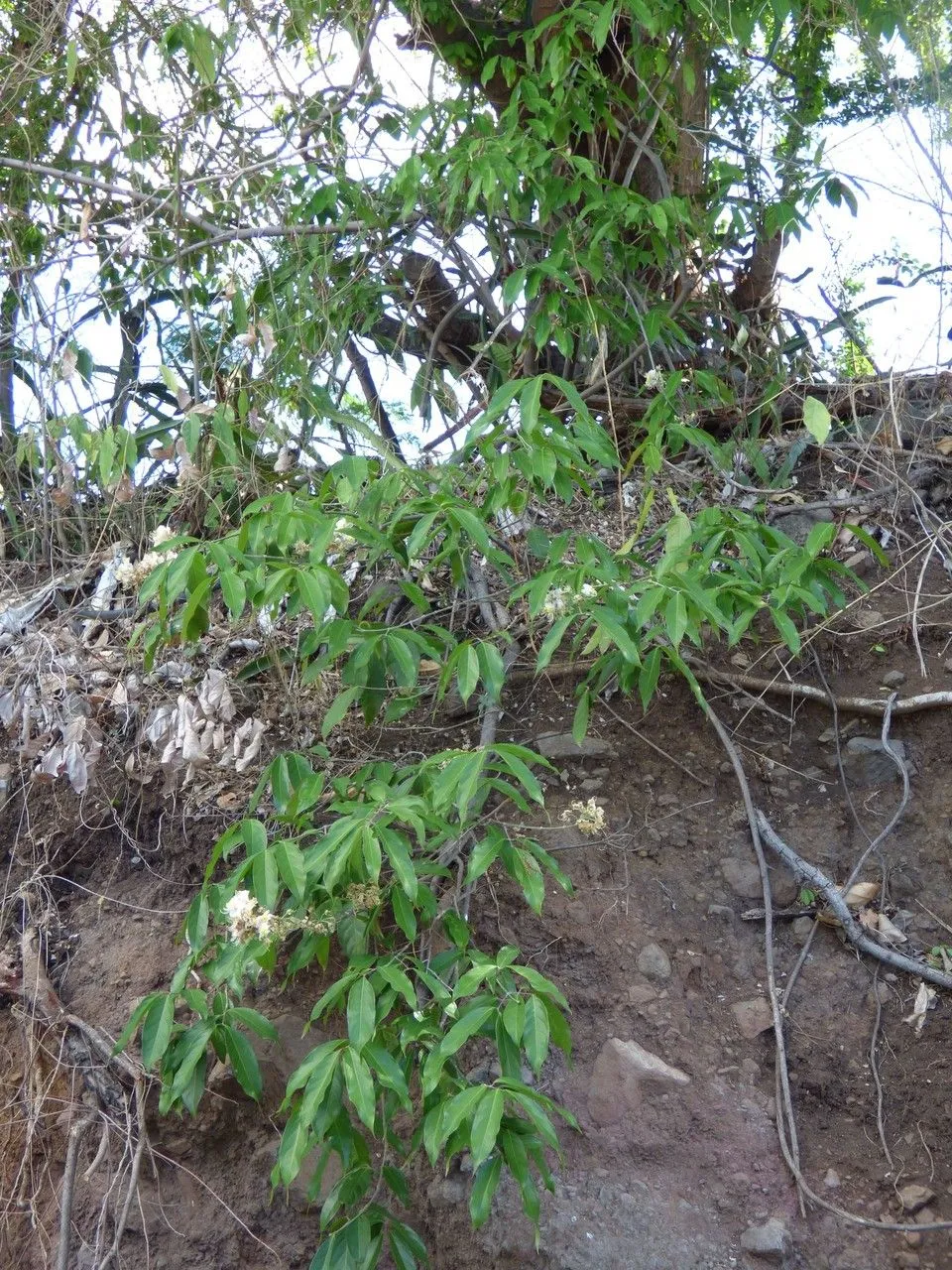
Author: (L.) Kurz
Bibliography: J. Asiat. Soc. Bengal, Pt. 2, Nat. Hist. 43: 136 (1874)
Year: 1874
Status: accepted
Rank: species
Genus: Hiptage
Vegetable: False
Observations: Trop. & Subtrop. Asia
Hiptage, scientifically known as Hiptage benghalensis, is a captivating and versatile plant that belongs to the family Malpighiaceae. This perennial plant is celebrated for its lush, dense foliage and its delicate, sweet-scented flowers, making it a favored choice among gardening enthusiasts and landscape designers.
The plant thrives predominantly in tropical and subtropical regions of Asia, displaying remarkable adaptability to these climates. Hiptage benghalensis grows as a woody climber or sprawling shrub, capable of reaching substantial heights when provided with adequate support. Its sprawling nature makes it an excellent option for covering large areas, arbors, or trellises.
One of the most enchanting characteristics of Hiptage is its flowers. Blooms are typically arranged in racemes and exhibit a beautiful mix of white and pink hues with a distinctive yellow spot at the base. These flowers often bloom in large clusters, creating a stunning visual display and emitting a pleasant fragrance that attracts a variety of pollinators, including butterflies and bees.
Beyond its aesthetic appeal, Hiptage benghalensis plays a significant ecological role. It is known to thrive in various types of soil and conditions, indicating its robust nature and ability to contribute to the stabilization of soil and prevention of erosion.
Despite its many positive attributes, Hiptage can be vigorous and somewhat invasive if not controlled properly. In some regions, it has the potential to outcompete native species, necessitating mindful cultivation practices to maintain ecological balance.
This plant was first described in significant detail in the prestigious “Journal of the Asiatic Society of Bengal,” Natural History section, volume 43, page 136, published in 1874 by the botanist W.S. Kurz, based on earlier classifications by Linnaeus (L.). This historical context highlights its longstanding recognition and importance within both horticultural and botanical fields.
In summary, Hiptage benghalensis is a plant of striking beauty and considerable resilience. Its aromatic flowers and lush foliage make it an appealing choice for enhancing garden spaces while offering numerous ecological benefits, provided it is managed with attention to its vigorous growth habits.
Eng: hiptage, helicopter-flower
Khm: ក្របីបី
En: Hiptage, Helicopter-flower, Clustered hiptage, Helicopter Flower, Madhavi latha
As: মাধৱী লতা
Bn: মাধবীলতা
Zh: 猿尾藤
Fi: Intiankolmisiipi
Fr: Liane papillon, Hiptage benghalensis, Liane de cerf, Liane du Bengale
De: Benghalen-Liane
Kn: ಮಾಧವೀಲತೆ
Km: ក្របីបី
Ml: മാധവി
Su: Areuy beurit
Zh-tw: 猿尾藤
Ta: குருக்கத்தி
Th: โนรา
Taken Oct 16, 2017 by Melanie Lobietti (cc-by-sa)
Taken Jul 1, 2018 by Hugo SANTACREU (cc-by-sa)
Taken Jun 2, 2016 by Hugo SANTACREU (cc-by-sa)
Taken Oct 14, 2021 by Oliveira Vander (cc-by-sa)
Taken Jul 1, 2018 by Hugo SANTACREU (cc-by-sa)
Taken Nov 14, 2015 by Tela Botanica − Hugo SANTACREU (cc-by-sa)
Taken Nov 14, 2015 by Tela Botanica − Hugo SANTACREU (cc-by-sa)
Taken Nov 14, 2015 by Tela Botanica − Hugo SANTACREU (cc-by-sa)
Taken Oct 10, 2019 by RAHMAN MAHFUJUR (cc-by-sa)
Taken Oct 19, 2021 by jean claude proux (cc-by-sa)
Taken Jan 8, 2014 by Tela Botanica − Anziz AHMED ABDOU (cc-by-sa)
Taken Jun 17, 2015 by Tela Botanica − Anziz AHMED ABDOU (cc-by-sa)
Taken Mar 16, 2018 by Tela Botanica − Liliane ROUBAUDI (cc-by-sa)
Taken May 26, 2022 by William Coville (cc-by-sa)
Taken Oct 13, 2017 by Hugo SANTACREU (cc-by-sa)
Taken Oct 16, 2017 by Hugo SANTACREU (cc-by-sa)
Taken Oct 13, 2017 by Hugo SANTACREU (cc-by-sa)
Taken Oct 13, 2017 by Hugo SANTACREU (cc-by-sa)
Taken Oct 13, 2017 by Hugo SANTACREU (cc-by-sa)
Taken Dec 14, 2016 by Hugo SANTACREU (cc-by-sa)
Taken Oct 13, 2017 by Hugo SANTACREU (cc-by-sa)
Taken Oct 1, 2016 by Hugo SANTACREU (cc-by-sa)
Taken Mar 16, 2018 by Tela Botanica − Liliane ROUBAUDI (cc-by-sa)
Taken Mar 16, 2018 by Tela Botanica − Liliane ROUBAUDI (cc-by-sa)
Taken Jun 17, 2015 by Tela Botanica − Anziz AHMED ABDOU (cc-by-sa)
Taken Jun 17, 2015 by Tela Botanica − Anziz AHMED ABDOU (cc-by-sa)
Taken Jun 17, 2015 by Tela Botanica − Anziz AHMED ABDOU (cc-by-sa)
Taken Jun 17, 2015 by Tela Botanica − Anziz AHMED ABDOU (cc-by-sa)
Taken Oct 2, 2016 by Hugo SANTACREU (cc-by-sa)
© copyright of the Board of Trustees of the Royal Botanic Gardens, Kew.
© copyright of the Board of Trustees of the Royal Botanic Gardens, Kew.
© copyright of the Board of Trustees of the Royal Botanic Gardens, Kew.
Family: Myrtaceae Author: (F.Muell.) K.D.Hill & L.A.S.Johnson Bibliography: Telopea 6: 402 (1995) Year: 1995 Status:…
Family: Rubiaceae Author: Pierre ex A.Froehner Bibliography: Notizbl. Bot. Gart. Berlin-Dahlem 1: 237 (1897) Year:…
Family: Sapindaceae Author: Koidz. Bibliography: J. Coll. Sci. Imp. Univ. Tokyo 32(1): 38 (1911) Year:…
Family: Asteraceae Author: A.Gray Bibliography: Pacif. Railr. Rep.: 107 (1857) Year: 1857 Status: accepted Rank:…
Family: Fabaceae Author: Medik. Bibliography: Vorles. Churpfälz. Phys.-Ökon. Ges. 2: 398 (1787) Year: 1787 Status:…
Family: Aspleniaceae Author: (Cav.) Alston Bibliography: Bull. Misc. Inform. Kew 1932: 309 (1932) Year: 1932…